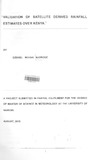| dc.description.abstract | The aim of the study was to strengthen the monitoring of rainfall over Kenya
by determining the validity of satellite derived rainfall estimates for use in
Kenya. The study analyzed eleven years of monthly rainfall estimates (1998-
2008) produced by Tropical Rainfall Measuring Mission (TRMM)'s 38-43
algorithm and compared them with thirty years (1979-2008) gridded monthly
rainfall totals from twenty six synoptic and Agrometeorological stations over
Kenya.
The first step in the study involved assessing the quality of rain gauge records
before they were included in this study. These monthly rain gauge records
were then gridded to a grid scale of 0.25 0 by 0.25 0 to match with the TRMM
satellite's rainfall estimates. The two gridded data sets were then compared
by plotting scatter diagrams for a dry season (January to February), a wet
season (March to May) and for the whole period of study. The results showed
that there was clustering of both variables at a certain point and there were
few outliers.
The results from simple correlation analysis revealed significant correlation
between Kriged rainfall and TRMM satellite's rainfall estimates. The largest value of correlation obtained was 0.9 for the dry season while the smallest
value was 0.847 in wet season.
Principal component analysis was performed in both spatial and temporal
modes to investigate the underlying physical processes which gave rise to the
two data sets. The first principal components were presented on spatial maps
for both Kriged rainfall and satellite rainfall estimates respectively. A pair of
maps with similar patterns, one for each variable, was obtained for the wet
season, dry season and for the whole period of study. Time series of the first
and the second principal components of the Kriged rainfall and TRMM
satellite's rainfall estimates revealed a common trend.The mean absolute percentage errors ranged from zero to 99.9% for PCA's
spatial mode against a target of 10% and threshold of 15%. The temporal
mode generated large errors ranging from 0.27% to 212%, however some of
these high errors in this mode are outliers since the average was 44.4%.
Mean errors (Bias) ranged from -0.024 to +0.03 for spatial mode while
temporal mode had errors ranging from -0.093 to +0.09 against the target of
±0.025 and threshold of ±0.038. Mean absolute errors (MAE) in spatial mode
ranged from 0.009 to 0.061 while those in temporal mode which ranged from
0.033 to 0.1727. The targeted and threshold MAE values were 0.025 and
0.038 respectively. Root mean squared errors (RMSE) ranged from 0.039 to
0.22 and 0.012 to 0.06 for temporal and spatial modes respectively. The
RMSE targeted and threshold values were 0.027 to 0.041. From these results,
temporal mode generated more errors than the spatial mode. In spatial mode
more than half of the country had errors within the acceptable range. The
TRMM's 3B43 algorithm tended to overestimate rainfall during the wet
season.
Canonical correlation analysis was done to determine a linear combination of
each of the two sets of variables such that the correlation between two
functions is maximized. CCA which is equivalent to multiple regressions was
also used to develop models for estimation of areal rainfall using satellite
derived rainfall estimates. The results from CCA revealed high correlation
coefficients between Kriged rainfall and TRMM rainfall estimates. For the
overall period of study eight out of ten Eigen vectors analyzed had CCA
coefficients greater than 0.5.
Based on these results it was concluded that satellite rainfall estimates can be
modeled to represent areal rainfall over areas lacking ground based rainfall
observation. In this study an attempt was done to design these models | en |

